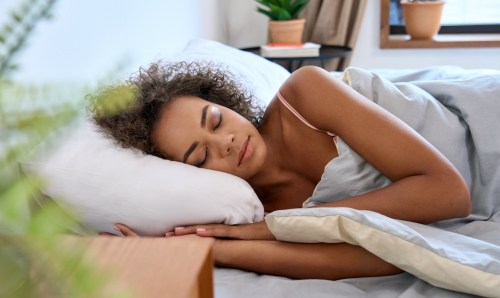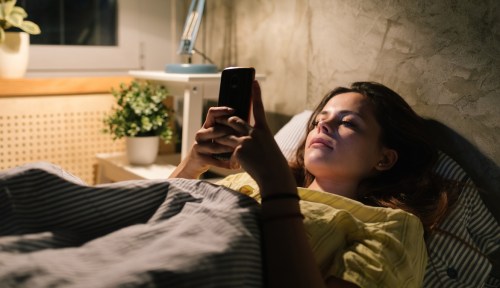I Tried Progressive Muscle Relaxation, a Simple Exercise to Help You ‘Flex’ Your Way to Sleep
Studies have show that progressive muscle relaxation can help relieve stress, pros say it can improve sleep. Here's how to try it out.

A relaxed mind and good sleep often go hand-in-hand. But as for actually achieving the mental calm that can help facilitate a good night’s rest? That’s another story for many of us.
Experts in This Article
sleep medicine specialist at Northwestern Medicine Central DuPage Hospital
assistant professor of psychiatry and behavioral sciences at the Johns Hopkins University School of Medicine
There are many mindfulness methods that aim to quiet the mind, but one method that is especially beloved by sleep doctors to ease the transition to dreamland is called progressive muscle relaxation. I can attest to its effectiveness—I fell asleep faster after I incorporated it into my bedtime routine for one week.
How progressive muscle relaxation works, and how it benefits sleep
Progressive muscle relaxation is a multi-step meditation process marked by alternating between tensing and releasing specific muscle groups to ease you into a state of calm. Physician Edmund Jacobsen, MD, PhD, developed the method in the 1920s to treat anxiety. The idea was that by alternating relaxing and constricting the muscles, a person could learn to identify what stress felt like in their body and then ease it themselves.
“Insomnia is really a condition where people can’t relax both the mind and the body. Progressive muscle relaxation works because it’s about that connection.” —Kuljeet K. Gill, MD, sleep medicine specialist
Essentially, progressive muscle relaxation engages both your body and mind to help address the full-body experience of stress. “If I meditate on all the things that make me stressed, that’s going to increase the stress,” says Luis Fernando Buevaner, PhD, assistant professor of psychiatry and behavioral sciences at the Johns Hopkins University School of Medicine. “But if I focus on something else, like fatiguing the muscles and deep-breathing to occupy those brain centers, that is going to have a different effect.”
Studies have shown progressive muscle relaxation to be an effective method for relieving stress and reducing symptoms of depression. It is also particularly effective for sleep. Some sleep specialists use the technique to treat patients with insomnia, and in a review conducted by the American Academy of Sleep Medicine, progressive muscle relaxation was found to be one of three “empirically supported psychological treatments for insomnia.”
“Insomnia is really about hyper-arousal of the mind and body, so it’s really a condition where people can’t relax both the mind and the body,” says Kuljeet K. Gill, MD, sleep medicine specialist at Northwestern Medicine Central DuPage Hospital. Progressive muscle relaxation “works because it’s about that connection,” she adds.
How to do a progressive muscle relaxation meditation for sleep
I was really excited to try progressive muscle relaxation because I’ve had issues getting to sleep for as long as I can remember. I’ve tried all sorts of interventions, like ditching my doom-scrolling habit, savoring happy memories, and wearing an eye mask. Meditation normally is tough for me, but the chance to combine movement and mindfulness felt like something I could manage.
This is what a basic progressive muscle relaxation sequence looks like, which you can complete either lying down or sitting up:
1. Establish a breath pattern
As with many mindfulness practices, breathing is a key part of progressive muscle relaxation. It calms the nervous system and helps guide movements—like setting a metronome before starting piano scales. Start by taking a deep breath in, holding it, and then exhaling slowly. “Ideally, inhalation is a little longer than exhalation,” Dr. Gill says. Then set your pace before you move on to step two.
2. Decide the origin point of where you’ll start your progressive muscle relaxation
As you are breathing, decide if you’re going to start from the bottom or top of your body first. When Dr. Buevaner teaches people how to do this, he typically starts with the arm (first the upper arm, then the forearms). Inhale and tense the first specific muscle or group, being sure to hold the position for at least five seconds. The muscles should feel taut and tense while you flex them. You should feel pressure, not pain; the muscle should contract but not to the point where it becomes stiff or painful.
3. Notice differences between flexed and relaxed muscles
Exhale and release the tension, focusing your attention on considering the difference between how the relaxed muscles feel compared to the tensed muscles. Dr. Buevenar recommends holding each position for at least five seconds, keeping your breath steady, to give yourself enough time to really marinate on this connection.
4. Repeat this process throughout the entire body, tensing up and then releasing different muscle groups.
Because this meditation is all about focusing on the mind and the body at the same time, Dr. Gill advises doing it at the same time each day to build a habit and to make it easier to concentrate on the connection as part of a routine. She also advises doing this close enough to when you’re actually getting in bed to usher sleep in easily. It typically took me 10 or 15 minutes to complete, but Dr. Gill says someone might benefit from even five minutes of the practice, if that’s all the time they have.
This method is all about listening to the body, so be sure not to push through any pain if you feel discomfort when you tense your muscles. “When I teach people how to do this, I say you want to contract between 70 and 80 percent so it’s enough for you to feel it, but not enough to give yourself a cramp,” Dr. Buevaner says. If you’re having trouble tensing or relaxing a certain muscle or muscle group or healing from an injury, skip that one and move onto the next one.
Don’t give up if it doesn’t come easily, either. As with many other pursuits, it gets easier with practice. Don’t get tripped up about the order of the sequence, for example, and instead focus on keeping the breath, tensing, and releasing controlled.
How progressive muscle relaxation worked for sleep when I tried it
Before the experiment
I decided to try progressive muscle relaxation every night before bed for a week to see if it would improve my ability to fall asleep. I decided to use a YouTube video from the U.S. Department of Veteran Affairs to walk me through a 14-minute exercise each night.
I’d compare how long it took me to fall asleep on the days I did the relaxation against my existing baseline. In order to fit the meditation into my existing bedtime routine (brush my teeth, apply skin care, put away my clothes and tidy up my room, lay out my clothes for the next day, and read in bed), I would start the going-to-bed process about 30 minutes earlier than usual.
With the parameters of the experiment in place, I was excited to start stretching—and hopefully, sleeping.
Trying progressive muscle relaxation every night before bed for one week
I first tried my guided meditation video on a Monday night after finishing my book. Standing next to my bed, I worked my way through the video and listened to the narrator’s cues. In the audio guide, the narrator says you may tense the muscles tightly or lightly, and choose to keep your eyes open or closed. I kept my eyes closed and started out with lighter pressure, in line with Dr. Buevenar’s recommendation to get a feel for the sequence.
In this video, the narrator instructs would-be meditators to begin by taking deep breaths and allowing air to flow into the abdomen, setting a rhythm with your inhales and exhales. Next, she says to check in with your emotional state and thoughts, “just noticing what’s happening without judgment or without expectation, just bringing them into your awareness.” I was surprised by how freeing it felt to acknowledge the longer-term worries (for example, some anxieties about family and upcoming trips) that had popped into my head over the course of the week. I hadn’t realized how much was actually on my mind, so bringing these thoughts to the forefront and then shoving them made me feel relaxed and ready to start the exercise.
I was surprised by how at ease I felt after night one…I climbed into bed, and the next thing I remembered, I was waking up in the morning.
I followed the instructor’s prompts to target tension all around my body, starting with the lower extremities and torso before finally ending with the head, neck, face, and jaw. For each muscle group, I was instructed to tense up, compare the feeling of the flexed muscle to the relaxed ones, then slowly release the tension, focusing on the sensation of the relaxed muscle compared to when it was tense. (All while keeping in sync with my breaths.)”Maybe you imagine this is like a fire hose that was rigid when it was full of water, that suddenly becomes more flexible as it drains out,” the narrator suggests.
I was surprised at how at ease I felt after night one. I genuinely felt almost disoriented when the narrator instructed me to open my eyes and reorient back to my surroundings—in this case, it was my room that I’d lit with candles and twinkle lights. I climbed into bed, and the next thing I remembered, I was waking up in the morning.
As the week progressed, I kept working through the routine at my designated time and reaping the benefits of a quick, blissful tumble into sleep after the rest of my routine. I also found that reading beforehand put my mind in a state to concentrate more easily, so maybe that was a helpful tool. I often toss and turn in bed, but I didn’t notice as much during the week I tried progressive muscle relaxation.
Throughout the week, I found myself tensing my muscles harder and aligning my breath with more ease. The novice meditator who began this experiment was gone, replaced by someone actually able to sit still long enough to reap the benefits of mindfulness. I knew that this technique was something should use on acutely stressful, sleepless nights.
Overall, I fell asleep faster on the nights I did progressive muscle relaxation. Usually after I turn out the lights, I spend about 10 minutes staring at the ceiling and trying to fall asleep. On nights I did progressive muscle relaxation, this time felt like it was cut in half. While my mind is usually playing catch-up with my body on the relaxation front before bed, they were both in sync on the nights I did progressive muscle relaxation.
The takeaway
Overall, I found progressive muscle relaxation got me in the right mindset to sleep. Quieting the thoughts that typically whoosh through my brain as I toss and turn through was a welcome change, and one I’d like to incorporate into my routine regularly. I plan to continue using the practice as part of my bedtime routine, but I may look up a shorter meditation. I will also be sure to use a guide again (another video or an app) until I get the hang of progressive muscle relaxation and can go without.
I’m happy to have found another sleep-inducing tool to add to my bedtime routine. Even if not every night, I’ll aim to try it maybe once a week or when I’m particularly stressed out and need extra help easing my mind.
—reviewed by Angela Holliday-Bell, MD
Sign Up for Our Daily Newsletter
Get all the latest in wellness, trends, food, fitness, beauty, and more delivered right to your inbox.
Got it, you've been added to our email list.










